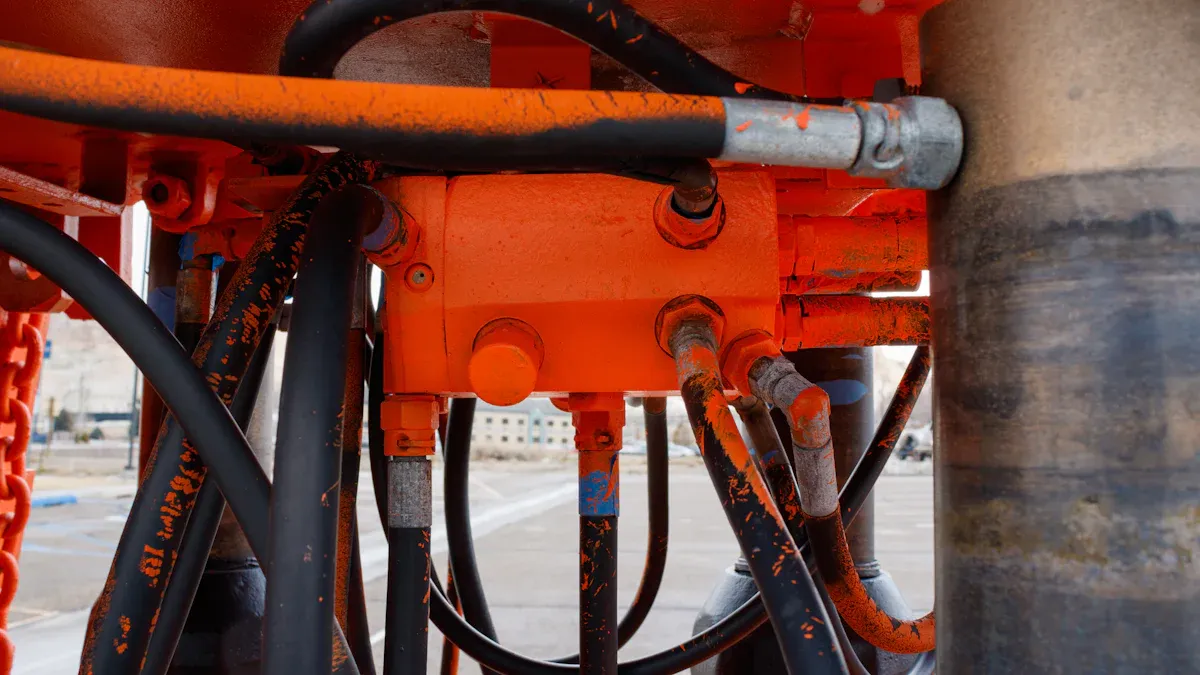
Not every hydraulic fitting stands up to high pressure. The right choice depends on material and design. If someone uses the wrong hydraulic hose fittings or stainless steel fittings, trouble can follow. Check out these common safety incidents:
| Safety Incident | Description and Consequences |
|---|---|
| Hose Bursts | Sudden hose rupture causing hydraulic fluid injection injuries that penetrate skin, requiring urgent medical care. |
| Equipment Damage | Burst hoses cause damage to valves, pumps, cylinders, and nearby components, leading to costly repairs. |
| Operational Downtime | Hose failures halt operations, causing production delays and financial losses due to repair and recovery time. |
| Leaks and Slip Hazards | Over-pressurization weakens hose structure causing leaks, which create slip hazards and risk of falls. |
| Environmental Contamination | Hydraulic fluid leaks contaminate soil, water, and ecosystems, requiring costly cleanup and posing legal risks. |
| Catastrophic System Failures | Pressure spikes from bursts can cause seal ruptures and loss of hydraulic control, risking operator safety. |
Parker hydraulic fittings, rubber hose, and stainless steel fittings all have different limits. Picking the right one keeps everyone safe.
Key Takeaways
- Choose hydraulic fittings based on their material strength and pressure rating to prevent leaks, bursts, and costly failures.
- Follow design standards and test methods like SAE J514 and ISO 8434 to ensure fittings meet safety and performance requirements.
- Match fitting materials to system pressure, environment, and fluid type, and always inspect and maintain fittings to keep hydraulic systems safe and reliable.
Hydraulic Fittings: What Determines Pressure Rating?
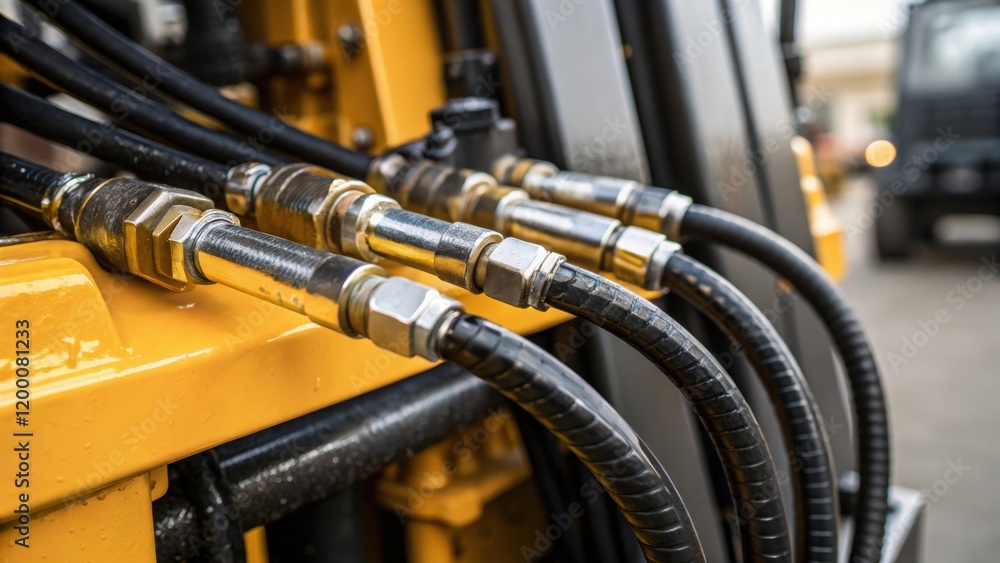
Material Strength and Properties
The pressure rating of hydraulic fittings depends a lot on the material used. Stronger materials can handle more force inside the system. Stainless steel and high-performance alloys stand out because they have high tensile strength. These materials can take repeated stress without breaking. For example, stainless steel fittings often have a tensile strength starting at 5,000 PSI and can go above 10,000 PSI for special alloys. Carbon steel works well for many high-pressure jobs but may need a coating to stop rust. Brass is softer and usually fits low or medium-pressure systems.
| Material | Typical Tensile Strength / Pressure Rating (PSI) | Notes on Usage in Hydraulic Fittings |
|---|---|---|
| Brass | 1,000 to 3,000 | Used in low to medium-pressure systems; lower tensile strength limits high-pressure use |
| Carbon Steel | Up to around 6,000 | Suitable for many high-pressure applications but may require corrosion protection |
| Stainless Steel | 5,000 to 6,000, up to 10,000+ | Preferred for high-pressure applications due to superior tensile strength and corrosion resistance |
| High-Performance Alloys | Above 10,000 | Used in extreme pressure scenarios, offering highest tensile strength |
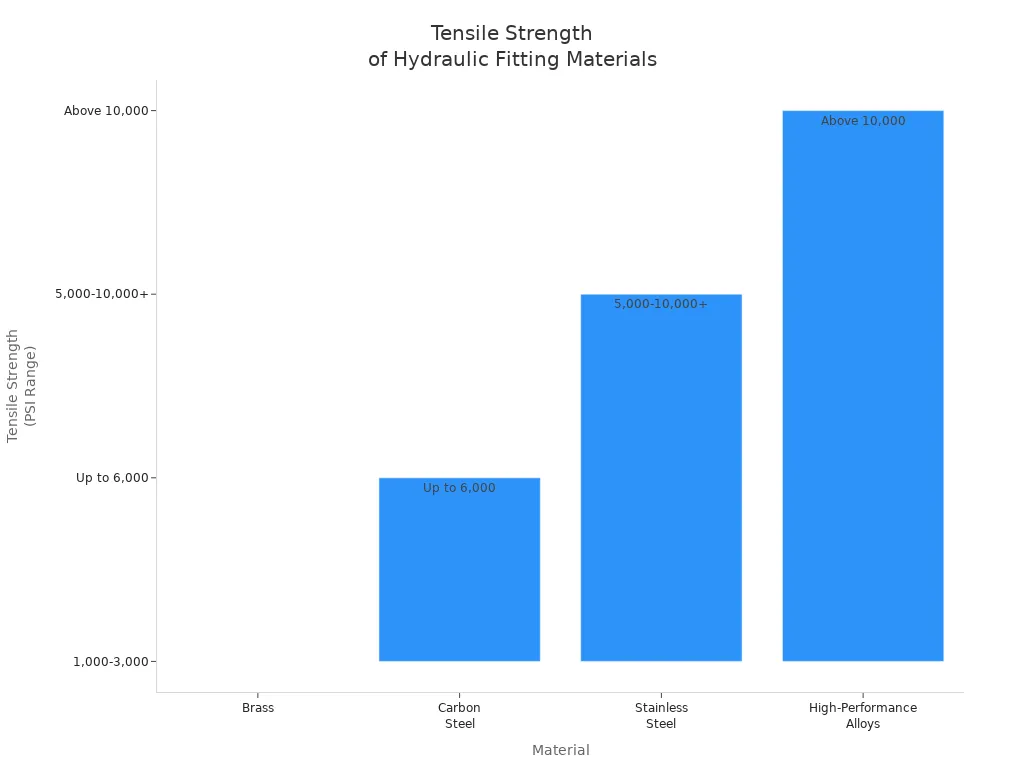
Tip: Harder materials like stainless steel keep their strength even when temperatures rise. Softer materials, such as aluminum, lose pressure capacity faster when things get hot.
Other factors also play a role:
- Wall thickness and fitting shape help decide how much pressure the fitting can take.
- Temperature changes matter. High heat makes metals softer and seals weaker. Cold can make some materials brittle.
- The type of hydraulic fluid can affect seals and materials. Some fluids break down seals or corrode metals.
- Pressure spikes and constant changes in pressure can wear out fittings faster. This is called fatigue.
- Safety margins are built in to handle unexpected pressure jumps or material changes over time.
Design and Manufacturing Standards
The way a hydraulic fitting is designed and made also affects its pressure rating. International standards, like SAE J514 and ISO 8434, set rules for how strong and safe these fittings must be.
| Aspect | SAE J514 | ISO 8434-2 |
|---|---|---|
| Pressure Ratings | Up to 6000 psi (approx. 414 bar) depending on material and fitting type | Up to approximately 450 bar (6500 psi) in metric systems |
| Test Methods | Hydraulic burst tests and cyclic pressure tests to ensure durability and performance | Similar hydraulic pressure and cyclic tests with emphasis on metric parameters |
| Design & Sealing | Flare and O-ring designs, common in North American high-pressure systems | Compression fittings with precise sealing, favored in European high-pressure applications |
| Regional Usage | Predominantly North America (automotive, industrial hydraulics) | Predominantly Europe (heavy machinery, marine systems) |
| Application Suitability | High and low-pressure systems, brass fittings for lower pressure | High-pressure systems requiring precision and reliability under fluctuating pressures |
Design features that matter most include:
- The shape and size of the fitting. Thicker walls and strong shapes handle more pressure.
- The sealing method. O-rings and metal-to-metal seals help prevent leaks.
- Thread design. Some threads, like JIC or NPT, hold better under high pressure.
- Quality of construction. Good materials and careful manufacturing mean fewer leaks and failures.
Manufacturing tolerances are also key. If a fitting is not made to exact measurements, it might not seal right. This can cause leaks or even bursts. Standards like ISO 8434 and SAE J514 make sure fittings meet strict rules for size and shape.
Testing is another big part of the process. Manufacturers use several methods to check if a fitting can handle its rated pressure:
- Hydrostatic Pressure Testing: Fittings are filled with liquid and pressurized to check for leaks.
- Burst Testing: Fittings are pushed until they fail to find the maximum pressure they can take.
- Pressure Cycling (Fatigue): Fittings are put through repeated pressure changes to see how long they last.
- Leak Testing: Special tools check for small leaks at seals or threads.
| Testing Method | Description | Advantages | Disadvantages |
|---|---|---|---|
| Hydrostatic Pressure Testing | Filling the fitting with liquid and pressurizing to check leaks and structural integrity. | Accurate, easy leak detection, effective for high pressure | Requires liquid, may not suit all environments |
| Pneumatic Pressure Testing | Using compressed air or gas to pressurize fittings when liquids are unsuitable. | Faster setup, no liquid needed | Higher safety risks, less sensitive to small leaks |
| Burst Testing | Pressurizing until fitting fails to find maximum pressure capacity. | Determines max strength and pressure limits | Destructive, fitting is ruined |
| Pressure Cycling (Fatigue) | Repeated pressure fluctuations to simulate real-world conditions and test durability. | Simulates real conditions, evaluates long-term performance | Time-consuming, needs specialized equipment |
| Leak Testing | Pressurizing and using detection tools to find leaks at seals or connections. | Non-destructive, quick, detects minor leaks | Does not assess overall strength, focuses on sealing |
Note: Always check the pressure rating and standard compliance before using any hydraulic fittings. This helps prevent leaks, bursts, and costly downtime.
Hydraulic Fittings Materials and Pressure Applications
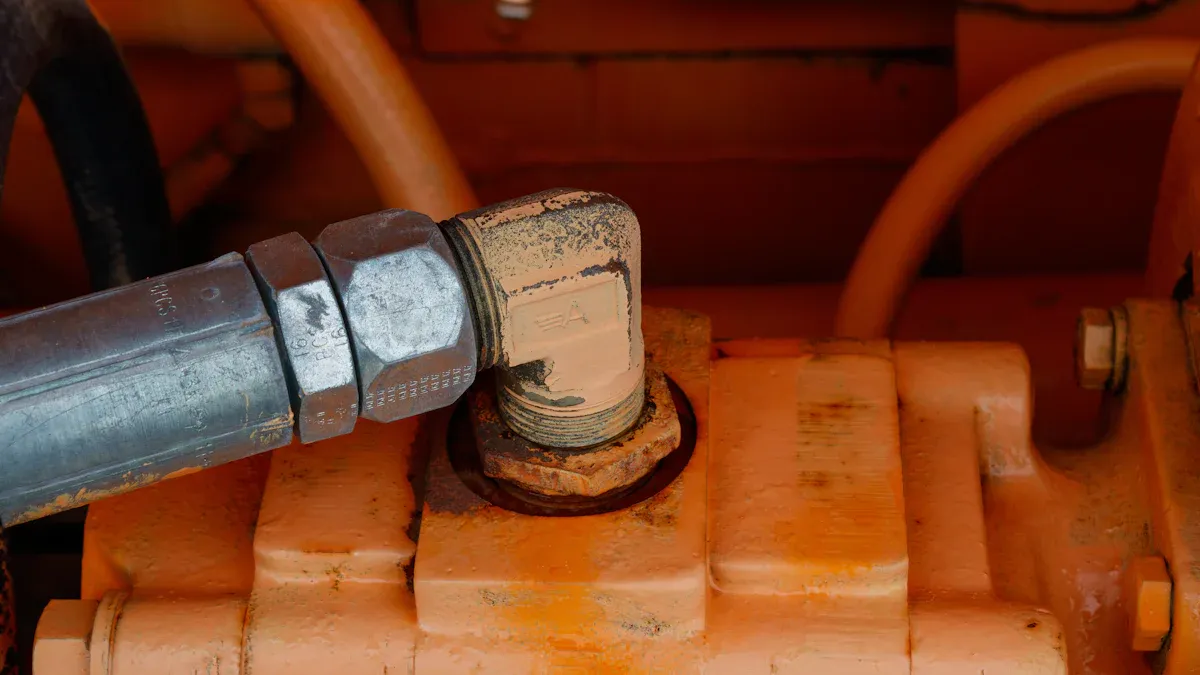
Steel Fittings
Steel fittings show up in many hydraulic systems because they handle high pressure and offer solid durability. Most standard steel hydraulic fittings work up to 5,000 or 6,000 psi, which covers a lot of industrial needs. Some special designs go even higher, but most factories stick with the standard ratings.
| Dash Size | Flange Type | Flange Size (inch) | Max Working Pressure (psi) |
|---|---|---|---|
| -8 | CODE 61 | 1-3/16 | 5000 |
| -8 | CODE 62 | 1-1/4 | 6000 |
| -12 | CODE 61 | 1-1/2 | 5000 |
| -12 | CODE 62 | 1-5/8 | 6000 |
| -16 | CODE 61 | 1-3/4 | 5000 |
| -16 | CODE 62 | 1-7/8 | 6000 |
| -20 | CODE 61 | 2 | 4000 |
| -20 | CODE 62 | 2-1/8 | 6000 |
| -24 | CODE 61 | 2-3/8 | 3000 |
| -24 | CODE 62 | 2-1/2 | 6000 |
| -32 | CODE 61 | 2-13/16 | 3000 |
| -32 | CODE 62 | 3-1/8 | 6000 |
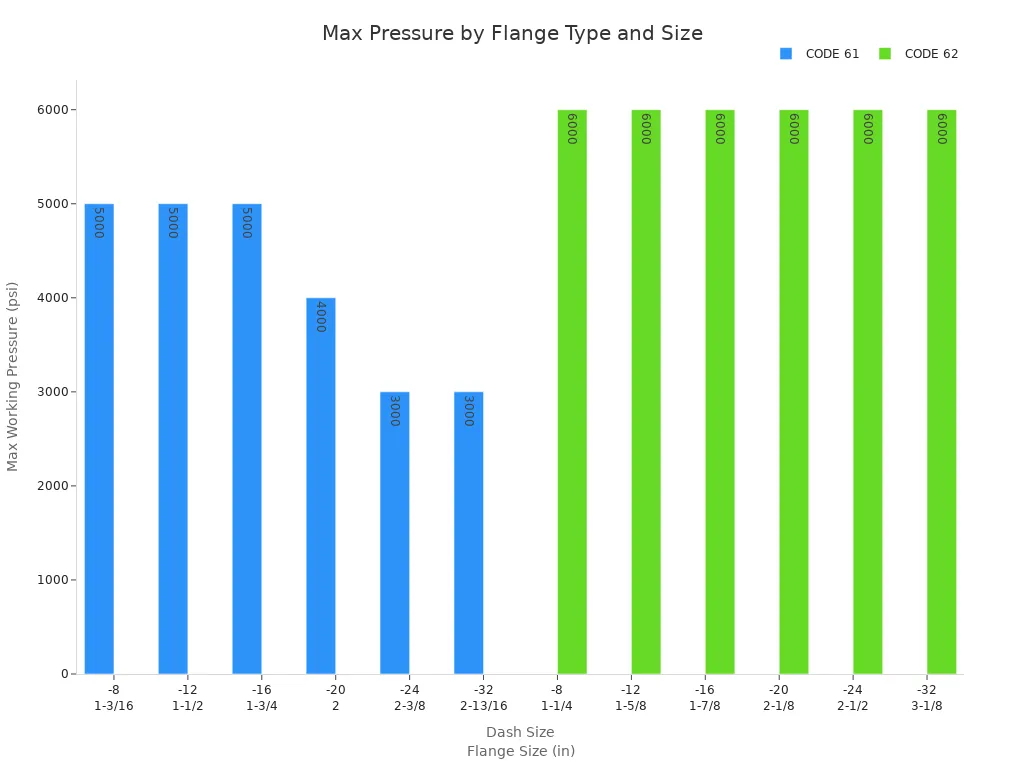
Steel fittings need protective coatings to fight rust. Without coatings, moisture and chemicals can cause corrosion, which weakens the fitting and lowers pressure reliability. When choosing steel, people should check for coatings like zinc-nickel to boost durability.
Stainless Steel Fittings
Stainless steel hydraulic fittings stand out for their strength and resistance to corrosion. These fittings often work up to 10,000 psi, and some special types can handle up to 20,000 psi. Stainless steel works well in harsh environments, such as marine, chemical, or oil and gas industries.
| Material Type | Typical Pressure Range (PSI) | Notes |
|---|---|---|
| Standard Stainless Steel | 5,000 to 6,000 | Common industrial applications |
| High-Grade Stainless Steel | Above 10,000 | Specially designed components |
| Brass | 1,000 to 3,000 | Used in low to moderate pressure systems |
Stainless steel fittings last longer because they resist rust and oxidation. The chromium in stainless steel forms a protective layer, so the fittings keep their strength even in wet or salty conditions. People pay more for stainless steel, but they get better pressure performance, fewer leaks, and less maintenance.
Stainless steel fittings cost about 50–100% more than brass, but they offer higher strength, better corrosion resistance, and longer life. For high-pressure or corrosive systems, stainless steel is the smart choice.
| Fitting Type | Brass Price Range | Stainless Steel Price Range | Performance Benefits of Stainless Steel |
|---|---|---|---|
| 1/2″ NPT Elbow | $2.50–$5.00 | $6.00–$12.00 | Higher tensile strength, better corrosion resistance, longer lifespan |
| 1″ Coupling | $4.00–$8.00 | $10.00–$20.00 | Superior pressure capacity, durability under harsh conditions |
| 2″ Tee | $10.00–$18.00 | $25.00–$50.00 | Excellent resistance to pitting and cracking, minimal maintenance |
Brass Fittings
Brass hydraulic fittings work best in low to moderate pressure systems. Most brass fittings handle between 1,000 and 3,000 psi. Brass resists corrosion better than mild steel, but it cannot match stainless steel for strength or durability.
Brass fittings face limits in high-pressure or harsh environments. Overloading can cause leaks, seal failures, or even bursts. Common problems include wear and tear, corrosion, and damage from vibration or temperature swings. Brass also suffers from galvanic corrosion when mixed with stainless steel in moist or salty places.
- Brass fittings are usually found in plumbing, HVAC, and some light industrial hydraulic systems.
- They cost less and are easy to install, but they need careful handling and regular checks to avoid leaks.
Aluminum and Plastic Fittings
Aluminum hydraulic fittings are light and resist corrosion, making them popular in cars and airplanes. Most aluminum fittings work up to 1,500 psi, though heavy-duty types can reach 4,000 psi. The SAE AS6116A standard sets the maximum for aluminum at 1,500 psi in mobile and aerospace hydraulic systems.
Plastic fittings, like polypropylene, offer good corrosion resistance but have low strength. These fittings work in low-pressure systems, such as labs or medical equipment. People use aluminum and plastic fittings when weight matters more than pressure.
| Fitting Type | Pressure Rating Range (PSI) |
|---|---|
| Heavy-Duty | 6,000 – 10,000 |
| Light-Duty | 1,500 – 4,000 |
Aluminum and plastic fittings are not suitable for high-pressure hydraulic systems. Stainless steel or steel fittings are better for those jobs.
Matching Material to Application Pressure
Choosing the right hydraulic fittings means matching the material to the system’s pressure and environment. People should look at pressure ratings, corrosion resistance, temperature limits, and cost.
| Material | Pressure Suitability | Corrosion Resistance | Temperature Range (°F) | Cost Ranking (High to Low) | Typical Applications / Notes |
|---|---|---|---|---|---|
| Stainless Steel | High pressure, corrosive env. | Excellent corrosion resistance | -325 to 850 | Most expensive | Preferred for high-pressure, corrosive, harsh environments; minimal maintenance; long service life |
| Carbon Steel | Medium to high pressure | Moderate (needs protective coating) | -20 to 750 | Lower cost | Cost-effective for many industrial uses; requires maintenance to prevent rust; coatings like zinc-nickel improve durability |
| Brass | Moderate pressure | Good corrosion resistance | -65 to 400 | Mid-range cost | Suitable for moderate pressure; moderate maintenance; good ductility and corrosion resistance |
| Aluminum | Lower pressure, weight-sensitive | Good corrosion resistance | -65 to 350 | Least expensive | Used where weight is critical; moderate corrosion resistance; moderate maintenance |

People should always check the system’s maximum pressure and temperature. The fitting material must match the hydraulic fluid to prevent corrosion or damage. Following manufacturer guidelines for installation and maintenance helps keep the system safe and reliable.
| Criterion | Explanation |
|---|---|
| Pressure Rating | Fittings must have a pressure rating that exceeds the system’s maximum operating pressure to ensure safety and reliability. |
| Material Compatibility | The fitting material must be compatible with the hydraulic fluid to prevent corrosion and damage. |
| Standards Compliance | Fittings should adhere to relevant standards such as ASME, SAE, or ISO to guarantee quality and suitability. |
| Environmental Factors | Consider temperature, chemical exposure, and humidity as they affect fitting durability and performance. |
| Fitting Type | Different fitting types (threaded, quick-connect, flange) are suited for different pressure and application needs. |
| Installation & Maintenance | Proper installation and regular maintenance are essential to maintain pressure integrity and prevent leaks. |
Using the wrong fitting material can cause leaks, system failures, and safety hazards. It also increases maintenance costs and downtime. Matching the right hydraulic fittings to the job keeps everything running smoothly and safely.
Choosing the right Hydraulic Fittings keeps systems safe and reliable. Experts recommend these steps before installation:
- Inspect fittings for damage or leaks.
- Confirm pressure ratings match system needs.
- Follow manufacturer guidelines and standards.
Case studies show that poor fitting selection or incorrect measurements can cause leaks, injuries, and costly downtime.
FAQ
Can all hydraulic fittings handle high pressure?
No, not every hydraulic fitting works for high pressure. They need strong materials and good design. Always check the pressure rating before using any fitting.
What happens if someone uses the wrong fitting for high pressure?
Leaks, bursts, or system failures can happen. People may get hurt. Equipment might break. Choosing the right fitting keeps everyone safe.
How does someone know which hydraulic fitting to pick?
People should look at the pressure rating, material, and standards. They can ask experts or check manufacturer guides for help.
Post time: Aug-25-2025
